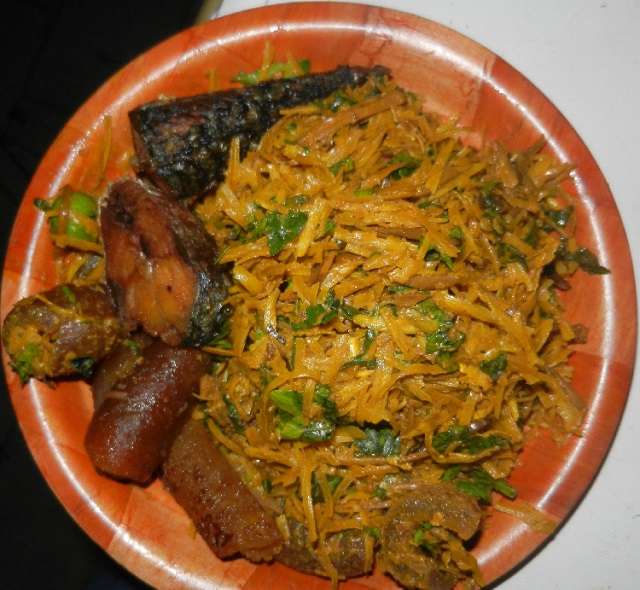If you really want to know how to prepare abacha, first, you must know what abacha is. Abacha is an eastern Nigerian delicacy, that has satisfied stomachs and taste buds for decades. Abacha is that inbetweener meal that precedes siesta. In Nigerian markets its common to see food vendors selling beautifully made abacha, so before you waste your mobile data watching a how to make abacha video, go to the market and ask those vendors their secret. Abacha, also known as African Salad, is made with a tropical plant found in Africa called the African oil bean. In Nigeria, the African oil bean is called ugba or ukpaka. The African oil bean tree is usually planted at the roadside and sold as cash crops. Before ugba can become one with abacha, it must be fermented and shredded. The best memories of abacha are probably in your grandparent’s house. When prepared, this meal can be heavily garnished, like regular salads and still taste just as good. Raw abacha itself is made from cassava. The cassava skin is peeled, the peeled tuber is then sliced and soaked in a large body of water such as spring water for 2 to 3 days. When soaked to perfection, it is left to sundry to harden and can be eaten like that with coconut. Who would’ve thought Just like everything else, practice makes perfect. As you practice and experiment, you won’t realise when you learn how to prepare ugba with ponmo and how to make Enugu African salad and how to make African salad without potash. Many people tend to ask, is abacha healthy? Abacha is packed with nutrients that perform amazing functions in the body. Some people who I will term as daring like to have nkwobi and ugba or they try to learn how to prepare ugba and okporoko which will still fall in the African salad category. Maybe one day we can give abacha and ugba sauce a try.
Ingredients for Abacha/African Salad
Ingredients used in making abacha or African salad vary from person to person. Some people like to get creative by adding garden eggs, onions and other vegetables or protein, where as some like it plain and simple. Here are the basic abacha ingredients.
- 3 handfuls of abacha
- 2 cups of ugba
- red palm oil
- Assorted fish
- 2 tablespoons powdered potash
- Onion(s)
- Salt
- Dry pepper
- 4 tablespoons ground crayfish
- 2 stock cubes
- Fresh utazi leaves
- Cow skin/ Kponmo
- 2 teaspoons of ground Ehu seeds (Calabash Nutmeg)

Ingredient Prep
Before making any dish, you realise some ingredients have to go through one process or the other off heat. This is important to get all ingredients ready before hand to reduce cooking time and have your dish turn out right.
- Soak the abacha for 2-3 minutes in cool water and put it in a sieve to drain.
- Soak the dry fish in cool water and set aside to soften.
- When the dry fish is soft, clean and debone. Then break into small pieces.
- Rinse the stock fish and cook till it’s soft. The stock fish should be deboned when it is soft. Don’t burn your fingers.
- Mix edible potash/limestone with some water, stir and set aside.
- Dice a part of your onions into tiny pieces and cut the other into rings.
- Rinse the leafy vegetable, cut some into tiny pieces, some into thin stripes and leave some leaves whole.
- Unwrap or take out your ukpaka/ugba and set aside.
- If you’re feeling creative, you can dice some garden eggs into tiny pieces and cut some into thin discs.
- Crack open the ehu seeds and grind till smooth.
- Grind/blend/pound the habanero pepper.

Directions
Having your ingredients prepped before hand makes it easier and faster to cook the abacha. This will ensure you have the right proportions of the ingredients, you don’t miss out any one, and your cooking space will be neat and easy to clean up right after cooking. Sometimes you might to just throw everything in the pot, however, if you do this, you will not get the desired results because ingredients have different cooking durations and temperatures and other conditions matter.
- Pour the palm oil into a pot. Pour the water from the potash mixture.
- Stir very well until you see the oil turn into a thick yellow paste. Ensure the edible potash sediments do not get into the pot.
- At this point, you have to take the pot off the fire. Off heat, add the ground pepper, ground ehu, stock cubes, diced onions, cray and ugba, then stir very well. Note that you should not do this on the fire.
- Add the ogiri and mix well.
- Add the diced cow skin or ponmo and stir very well.
- Carefully add the soaked and drained abacha and stir till it is well mixed in the palm oil paste with other ingredients.
- Add salt to taste and stir well. Make sure to add salt last because after packing in all the seasoning, there may be no need for salt. Also, taste the food before adding salt to know whether there is a need for salt.
- If you like your abacha warm, you can put the pot of abacha back to heat. Let the abacha warm up on low to medium heat. When it is ready, turn off the heat and if you desire, you can add sliced garden egg leaves, stir very well and serve as pleased.
- If you like your Abacha cold, ignore step 8 and add your desired garnishing ingredients and serve with a nice cold drink or water.







